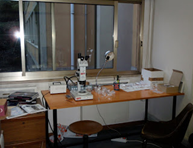Here is an image of the lab in Bologna, Italy that members of the Po Plain research team worked in separating and identifying gastropods (snails) and bivalves. Identifying each shell to species can be a real challenge! After being removed from the sediment core, the shells are separated by hand. A microscope is used to go through the sample to find small shells that might have otherwise been missed, and also to help count the shells. Both the species identity and the quantity for each species are important information in determining the depositional environment of the sediment core. In a sample of 100 shells, it can take around 30 minutes to process (identify and count) a single sample.
The bivalve species Lentidium mediterraneum is the most abundant and common bivalve in open marine inner/outer shelf depositional environments in the Po Plain cores. These shells are very tiny, but are robust, which means they are less likely to be broken and whole shells are easy to recover from the cores. Within one sample, 1,000s of shells from this one species can be found, which makes counting them a very time consuming process!
